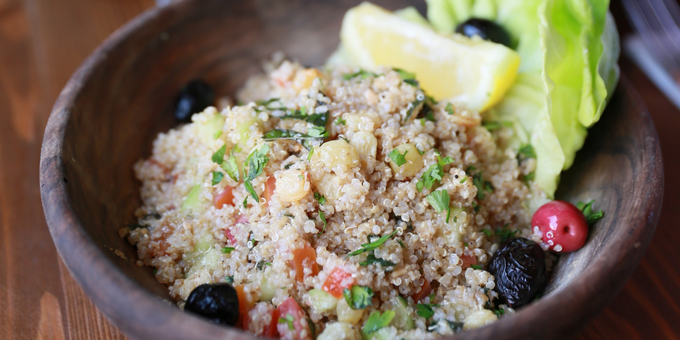This small, humble grain is a nutritional powerhouse and definitely worth the hype – not only is quinoa packed with the essentials, it may also support the health of diabetics and pre-diabetics.
It’s one of the few complete sources of plant-based protein, meaning it contains all 9 essential amino acids, but that’s not the only way in which quinoa is unique – it’s also a heart-healthy grain that can stabilise blood pressure and blood sugar levels.

Diabetes is a metabolic condition that affects 8.5% of adults around the globe that causes millions of deaths every year. Between 2000 and 2016 alone there was a 5% rise in premature death rates caused by diabetes.
A few switch-ups on our plates go a long way to preventing type 2 diabetes, along with reducing the severity of symptoms for those living with the condition. For starters, quinoa makes for an excellent option – here’s why.
Potassium and magnesium levels.
Quinoa is one of the most nutritionally dense grains – well, technically it’s a seed, but it packs a mighty punch. With excess potassium and magnesium levels, coming in at 15% and 28%, respectively, this unassuming seed knocks the competition out of the water. For comparison, rice only provides 2% of our daily potassium needs, while pasta only has around 5%, depending on the brand.

Here’s why this matters. When we don’t have enough potassium, the body makes less insulin – the result? High blood sugar, which is a problem associated with – you guessed it – diabetes. Studies have found that higher potassium intakes reduce the risk for diabetes, along with drastically improving the severity of existing conditions. Magnesium is the other hero nutrient in quinoa which helps regulate blood sugar levels, in fact, increased intake has been found to decrease the risk for diabetes by 22%.
Slow-release energy.
Quinoa belongs to a group of foods that provide slow-release energy, also known as complex carbs. These carbs are less likely to spike blood sugar levels than their fast-release counterparts like rice and white flour, and they also provide more consistent energy throughout the day. They take longer to digest, therefore preventing blood-sugar spikes and keeping you fuller for longer.
- Quinoa is more nutritionally balanced than rice and white bread.
- It helps stabilise blood sugars.
- Their prebiotic content plays a role in gut health, which is essential for diabetes management.
Fibre.
Fibre plays an important role in slowing down sugar absorption and, as a result, it improves digestion and lowers blood sugar levels. For type 2 diabetics, this is essential in reducing the symptoms.
But, here’s the problem: only 5% of us are getting enough fibre. 19 to 38 grams per day is the current daily intake recommendation – for reference, just one cup of quinoa packs 5 grams of fibre. This is where adding in a serve of quinoa to your plate can help make sure your body doesn’t miss out on this heart-healthy nutrient.
If you’re looking to better manage your blood sugar levels and enjoy a healthier lifestyle, we challenge you to join us in the 8-Week Program.
How does the 8-Week Program work?
When you sign up to the program, you’ll have access to extensive plans, community support and exclusive access to our sugar-free content. Here’s what’s on offer:
- 8 weeks of expert-crafted meal plans and shopping lists.
- 90+ member-only recipes.
- Community forums to share your journey.
- Support from the I Quit Sugar team, plus our panel of experts.
- Mental and physical health benefits that last a lifetime.
If you’re ready to transform your health and say goodbye to sugar crashes, JOIN NOW!






I Quit Sugar
November 03, 2023
Hey Myra, thanks for reaching out! Along with seeking medical support, we recommend incorporating a balanced diet rich in whole grains, lean proteins, and fresh fruits and vegetables. Avoid sugary beverages, sweets and ultra-processed foods (like ready-made meals, frozen chips, 2 minute noodles etc). Choose complex carbohydrates like brown rice and quinoa over white bread or white rice, and be sure to monitor portion sizes and maintain a consistent eating schedule to ensure your body can get into a regular pattern. (On that note, sleep is also really important as quality sleep plays an important role in balancing blood-sugar levels and our hormones) Go for healthy fats, like those found in avocados and nuts – these will provide long-lasting energy – but avoid trans fats found in deep-fried foods. Spices like turmeric, cinnamon and fenugreek can be so beneficial for balancing blood-sugars, so feel free to add spices generously to meals – we love a good curry as you can incorporate all these elements: veggies, spices, yoghurt and brown rice.
Herbal teas like green tea and chamomile tea are great additions to help curb sugar cravings while also contributing to balanced blood-sugar levels. Fermented foods like yogurt, kimchi, sauerkraut and tempeh can also help – they’ll boost gut health in general, so we recommend adding a dose of these foods to meals.
All the best for your husband’s health journey – feel free to reach out if you have any questions or need any support!
xx The IQS Team